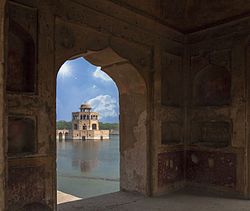Sheikhupura District
Sheikhupura District
ضلع شیخوپورا ضلع شیخوپورہ | |
|---|---|
 Hiran Minar | |
 Map of Sheikhupura District highlighted | |
| Country | |
| Province | |
| Division | Lahore |
| Headquarters | Sheikhupura |
| Government | |
| • Type | District Administration |
| • Deputy Commissioner | Mr. Rana Shakeel Aslam |
| • District Police Officer | N/A |
| • District Health Officer | N/A |
| Area | |
| • Total | 3,030 km2 (1,170 sq mi) |
| Population (2017)[1] | |
| • Total | 3,460,426 |
| • Density | 1,100/km2 (3,000/sq mi) |
| Time zone | UTC+5 (PST) |
| Tehsils | Sheikhupura Ferozewala Muridke Sharaq Pur Safdarabad |
| Website | sheikhupura |
Sheikhupura District (Punjabi: ضلع شیخوپورا; Urdu: ضلع شيخوپورہ), is a district located in Lahore Division of Punjab Province, Pakistan. Sheikhupura is the headquarters of Sheikhupura district. According to the 1998 census of Pakistan, the district had a population of 3,321,029 of which 25.45% were urban.[2] In 2005 one of its subdivisions was split off to form the new Nankana Sahib District. Before the Partition of Punjab(1947), there were more than 150 villages of Virk Jatts in the district of Sheikhupura.[3]
The predominant language of the district is Punjabi, which according to the 1998 census results for the tehsils of Sheikhupura, Ferozewala and Safdarabad, is the first language[4] of 98% of the population, while Urdu is the first language of 1.1%.[5]
According to the 2017 Census of Pakistan, most populous cities of the district are Sheikhupura, Muridke, Kot Abdul Malik and Ferozewala. All these four cities are listed in the List of most populous cities in Pakistan.
Tehsils
The district comprises 5 tehsils:[3]
- Sheikhupura
- Ferozewala
- Muridke
- Sharaq Pur
- Safdarabad (part of Nankana Sahib District between 2005 and 2008)
Committees
List of Municipal Committees in District Sheikhupura
- Sheikhupura Municipal Committee
- Farooq abad Municipal Committee
- Mananwala Municipal Committee
- Safdar abad Municipal Committee
- Khanqah dogran Municipal Committee
- Ferozwala Municipal Committee
- Kot Abdulmalik Municipal Committee
- Muridke Municipal Committee
- Narang Mandi Municipal Committee
- Sharaqpur Municipal Committee
Demographics
At the time of the 2017 census, Sheikhupura district had a population of 3,460,426 of which 1,786,383 were male and 1,673,242 female. 2,258,491 which is 65.26% of the population lives in rural areas while 1,201,513 which is 34.72% of the population lives in urban areas. 97.07% of the population spoke Punjabi, 1.28% Urdu and 1.01% Pashto as their first language. 96.10% of the population was Muslim and 3.77% Christian.[6]
| Religion | Population (1941)[7]: 42 | Percentage (1941) |
|---|---|---|
| Islam |
542,344 | 63.62% |
| Sikhism |
160,706 | 18.85% |
| Hinduism |
89,182 | 10.46% |
| Christianity |
59,985 | 7.04% |
| Others [c] | 291 | 0.03% |
| Total Population | 852,508 | 100% |
See also
References
- ^ "DISTRICT WISE CENSUS RESULTS CENSUS 2017" (PDF). www.pbscensus.gov.pk. Archived from the original (PDF) on 29 August 2017.
- ^ Urban Resource Centre (1998 Census) Archived 2006-05-13 at the Wayback Machine
- ^ a b "Sheikhupura - Punjab Portal". Retrieved 13 December 2016.
- ^ "Mother tongue": defined as the language of communication between parents and children.
- ^ 1998 District Census report of Sheikhupura. Census publication. Vol. 79. Islamabad: Population Census Organization, Statistics Division, Government of Pakistan. 2000. pp. 105–6.
- ^ "District Census 2017 - Pakistan". pbs.gov.pk. Pakistan Bureau of Statistics. 2017.
{{cite web}}: CS1 maint: url-status (link) - ^ "CENSUS OF INDIA, 1941 VOLUME VI PUNJAB PROVINCE". Retrieved 21 July 2022.
- ^ Historic district borders may not be an exact match in the present-day due to various bifurcations to district borders — which since created new districts — throughout the historic Punjab Province region during the post-independence era that have taken into account population increases.
- ^ 1941 census: Including Ad-Dharmis
- ^ Including Jainism, Buddhism, Zoroastrianism, Judaism, or not stated
External links
Coordinates: 31°43′12″N 73°58′48″E / 31.72000°N 73.98000°E
- Webarchive template wayback links
- CS1 maint: url-status
- Articles with short description
- Short description with empty Wikidata description
- Use dmy dates from October 2019
- Use Pakistani English from October 2019
- All Wikipedia articles written in Pakistani English
- Pages using infobox settlement with bad settlement type
- Pages using infobox settlement with no coordinates
- Articles containing Punjabi-language text
- Articles containing Urdu-language text
- Commons category link is defined as the pagename
- AC with 0 elements
- Coordinates not on Wikidata
- Sheikhupura District
- Districts of Punjab, Pakistan
